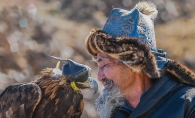Jennifer Gockowski’s new business, Jennifer Illustrations, came to be just like many great things in life—after a long and winding road of career changes, not all of which were in her control. But her love of art started long before the word “career” was on her mind.
“I started drawing cartoons in middle school,” she says. And in high school she would open up National Geographic and draw the animals inside. “Between all the hard classes I was taking, that was my relief.” She went on to college and studied marine biology, and finally ended up in veterinarian school at the University of Wisconsin-Madison.
While in vet school, “I got a job for a while in Madison working for the National Wildlife Health Center … they were doing a new big textbook and they needed an illustrator,” Gockowski says. They said they’d give her $12 an hour to draw for the book, and she said yes. It was shortly after that she had a realization: “We’d be in surgery classes and the professors would throw up little sketches of something and [say], ‘This is the stomach.’ Like, it’s a circle,” she recalls. “I’m spending $20,000 to be here and you don’t have somebody on staff who can do great graphics?”
That’s when she discovered, with the help of surgeons at the vet school, a program in California for scientific illustrators. Gockowski went, studied, moved back to Madison, and had a great client base for a few years, working on her own schedule. Until 2008.
When the recession hit, “all the projects were cancelled. … I no longer had work,” Gockowski says. So she did odd jobs and bartended to make ends meet. Then in 2009 she met her husband, Tom. A pilot, and living in Portland, Tom got a job through a Delta affiliate, Compass, in Minneapolis, and the two moved to the Twin Cities that year, finally settling in Woodbury in 2012.
“So in moving here, I had no client base anymore,” Gockowski says. “I had to have random jobs again.” And then she got pregnant with their son, Timmy. “It was a safe pregnancy but … I was not one of those [women] who was glowing. I was sick, and truly sick, the first trimester.” So her husband suggested she stay home and focus on being healthy. Gockowski was always an independent career woman, she says, but she knew she wanted to stay home with the baby in the beginning anyway, since Tom’s job had him away from home for days at a time.
It was while she was pregnant at home that the creative juices started flowing again. “I painted this world map for [Timmy] in his room and that was fun, but then I [thought], what else do I want to do?” So she started experimenting with the scratch board technique.
The technique involves a Masonite board, “kind of like compressed wood,” Gockowski says, and white clay is baked onto the surface. While some involve color, she uses ones with black ink completely covering the surface. “And then you can use any tool you want,” and start scratching away. This does mean mistakes can ruin the whole piece. “I just use an x-acto knife with a really small blade, and through different depths that you scratch at, and the angle of the blade,” you make different marks.
On her first try, Gockowski sketched a dog, and her friends told her it was really good. So she kept practicing.
Then in the spring of 2016, when Timmy was around 10 months old, Gockowski was tired. “It was really difficult through that first year. I was really kind of losing myself and I think Tom could see it,” she says. So he had an idea. He’d just seen an old high school friend—they went to Hill-Murray High School—who lived in New York City. His friend, Ted Dickhudt, had gotten a new apartment and adopted a rescue dog, a husky mix named Kilo. Tom suggested Gockowski do a scratchboard portrait of Kilo for Dickhudt to put up in the new apartment.
After Dickhudt sent photos of Kilo, “I started working on it and within a week I was happier than I’d been the whole pregnancy,” Gockowski recalls.
She was “sending me pictures of her work along the way,” Dickhudt says. “Watching the work developing in phases—an outline of Kilo’s silhouette, then an ear, then the nose, eyes and fur—was fascinating.” The final product did not disappoint, Dickhudt says. One of his favorite qualities of Kilo are her eyes, which he says makes her look tranquil and perceptive. “I really like that about her and … [it] had to capture that essence. I couldn’t be happier with Jen’s scratchboard because of the eyes. They’re there. They’re present, almost real.”
This is when Tom knew his wife had found her calling. “It turned out absolutely gorgeous and she really captured the personality of the dog,” he says. While being successful in the art was great, the effect the work had on Gockowski was even more important. “Jen handled the transition to motherhood like a champ, but I could tell it was wearing her out a little,” her husband says. “After she started doing this, and the projects kept coming, she was just more relaxed.”
So she kept going, and word spread, and commissions started flooding in. Susan Schaumburg’s labradoodle, Louis, (or Louie P. Doodle) was not an easy one with his curly hair, but Gockowski captured his personality perfectly, Schaumburg says. “Louis is very expressive and she nailed it. Louis [has] moved across the country with me. He has been my constant, and I don’t know what I’d do without him,” Schaumburg says. “His portrait makes me smile every time I see it. I think it will forever.”
And that’s what Gockowski hopes to accomplish, whether the dog is living or has passed away. “People are still embarrassed to say their pet is their family member, but of course they are [family],” she says. “This is a being that loves you no matter if you’re [angry] at your partner or your child, or you’re depressed or you haven’t cleaned up the house. They do not care. They think you are the most awesome being in the world.”
But she doesn’t want to limit her work to dogs, she says. Friends with horses have requested portraits, and she’d love to do cats as well. But truly, she’s just happy working on the art. “It’s like meditation,” she says. “Every day I see progress.”









